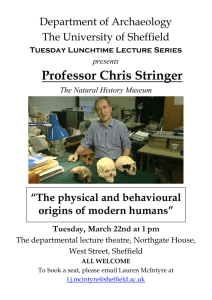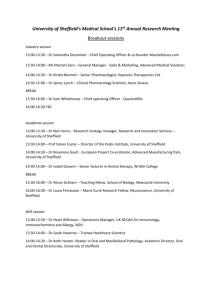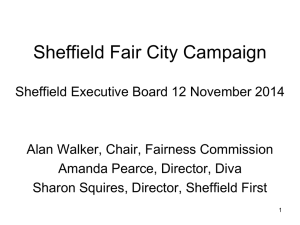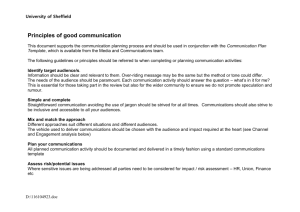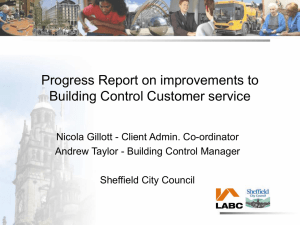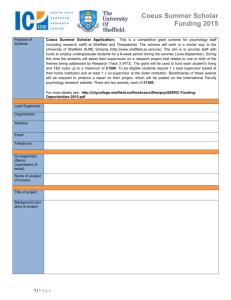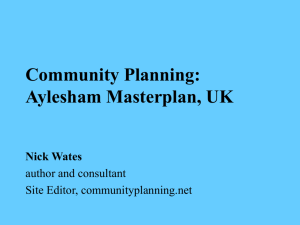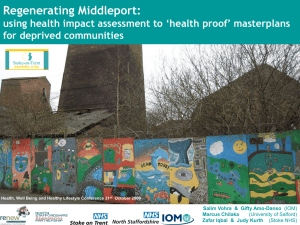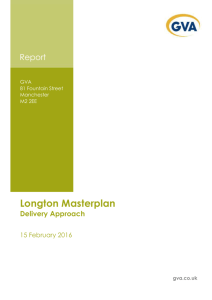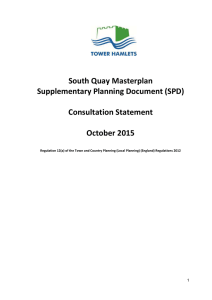Sheffield-Rotherham Masterplan Workshop Feedback
advertisement
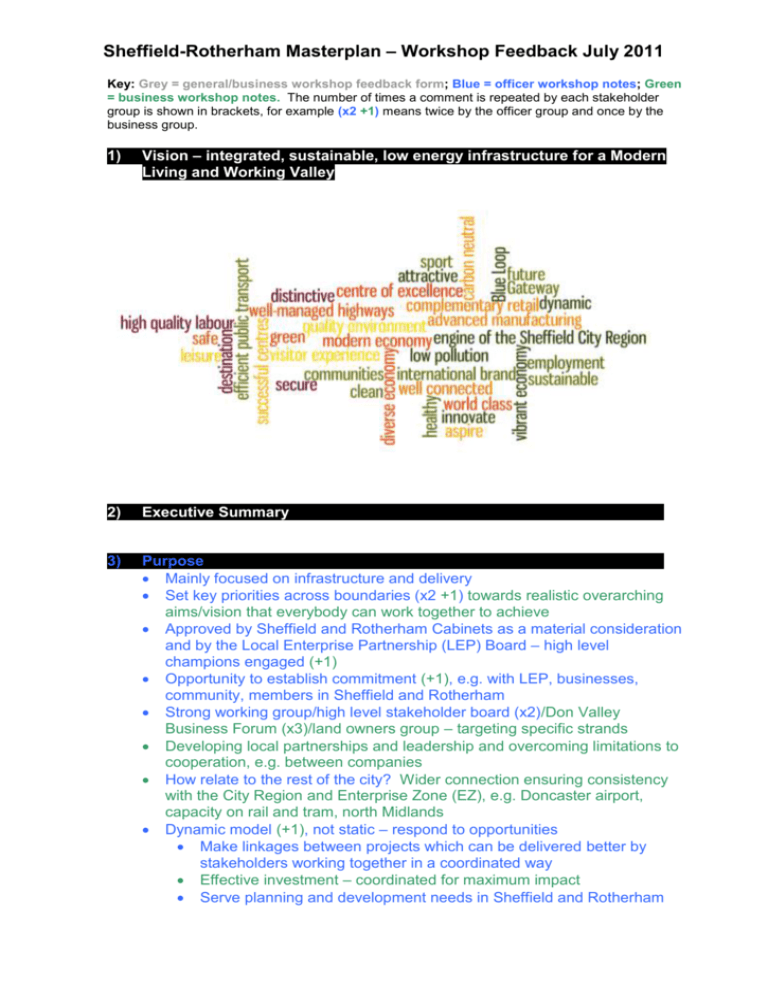
Sheffield-Rotherham Masterplan – Workshop Feedback July 2011 Key: Grey = general/business workshop feedback form; Blue = officer workshop notes; Green = business workshop notes. The number of times a comment is repeated by each stakeholder group is shown in brackets, for example (x2 +1) means twice by the officer group and once by the business group. 1) Vision – integrated, sustainable, low energy infrastructure for a Modern Living and Working Valley 2) Executive Summary 3) Purpose Mainly focused on infrastructure and delivery Set key priorities across boundaries (x2 +1) towards realistic overarching aims/vision that everybody can work together to achieve Approved by Sheffield and Rotherham Cabinets as a material consideration and by the Local Enterprise Partnership (LEP) Board – high level champions engaged (+1) Opportunity to establish commitment (+1), e.g. with LEP, businesses, community, members in Sheffield and Rotherham Strong working group/high level stakeholder board (x2)/Don Valley Business Forum (x3)/land owners group – targeting specific strands Developing local partnerships and leadership and overcoming limitations to cooperation, e.g. between companies How relate to the rest of the city? Wider connection ensuring consistency with the City Region and Enterprise Zone (EZ), e.g. Doncaster airport, capacity on rail and tram, north Midlands Dynamic model (+1), not static – respond to opportunities Make linkages between projects which can be delivered better by stakeholders working together in a coordinated way Effective investment – coordinated for maximum impact Serve planning and development needs in Sheffield and Rotherham Sheffield-Rotherham Masterplan – Workshop Feedback July 2011 Creating a platform for long-term sustainable growth, encouraging exporters Defining the Don Valley’s unique selling point 4) Context – Background, recent regeneration history, challenges, opportunities Jacobs Study for European Regional Development Fund (ERDF) Objective 1 for Sheffield-Rotherham Don Valley (S-RDV)/M1 Corridor (J33-35) – existing resource still rings true Blackburn Valley masterplan. May stretch scope too far, but good to refer to Sheffield City Council (SCC) Infrastructure Delivery Plan – should be mapped by January, need and demand will then be overlayed Pipeline of industrial premises stock study Local Enterprise Partnership and Enterprise Zone Insurance increases due to flood (60% confirmed at Business Workshop) 5) Policy review – summary of recent plans and policy and gap analysis 6) Development Opportunities Joint 2nd priority to respondents of the Business Workshop feedback form Developing relations with existing land owners and developers Issue of lots of vacant land (x2) and land banking a) Manufacturing Right property offer – issue of lots of empty units that don’t meet the requirements of modern manufacturing Issue of no speculative development for manufacturing – accommodation required for manufacturing support services/supply chain b) Commercial Empty offices Economic analysis to demonstrate what employment property is needed. Flagship Drop-in hot-desking facility with travel links for all users Issue of no speculative development of new offices c) Sport and Leisure d) Housing e) Retail/local Centres Ann Cadman and the Source as key champion for retail British Land development proposal Retail policy f) Jobs and Training Skills (+2) especially strong in manufacturing, local labour, up-skilling, apprenticeships (quality currently needs strengthening), basic skills, workplace discipline Sheffield-Rotherham Masterplan – Workshop Feedback July 2011 Engage and inspire young people What is our target market, who are we delivering for? High level, e.g. for Rolls Royce, advanced manufacturing opportunities (x2), etc Local skills and links to Rotherham Higher commuter rate and links to public transport needs g) Utilities (x2) Sewage, electricity, gas, telecoms Reliability/resilience of power/energy supply (x2), e.g. IT, data centres Broadband/digital region (x2 +1)/high speed broadband – links to job and skill opportunities, data centres (x2) Infrastructure availability schedule required for all utilities – too difficult and disjointed at present so utility companies need to be engaged now 7) Enterprise Zone and other incentives Clarify Local Enterprise Partnership’s endorsement process flowing on to tax income distribution Establishing the actual benefits of the Enterprise Zone beyond marketing and promotion Ensuring that EZ monies are used to support and further grow the area a) Innovation b) Investment Ensure LEP Board are bought in to the Masterplan to secure LEP funds Gearing up opportunities for businesses – loans increase 8) Transport Top priority and top barrier to respondents of the Business Workshop feedback form (+3), as well as a priority for the LEP Congestion reduction a priority (+1), including at Arena Square and in Attercliffe – area not attractive at the moment South Yorkshire Passenger Transport Executive (PTE) as a facilitator for travel and traffic issues – SY Local Travel Plan and funding for sustainable travel in South Yorkshire Cross-boundary transport issues Higher commuter rate and links to public transport needs Snow plans a) Bus Rapid Transit (BRT) North/Tinsley Link (+1) Junction 34 management (+1) BRT as an example of co-working across boundaries to be replicated on other projects such as flood and district heating b) Tram-Train and tram extension (+2) Stops at Magna – to be championed through the Masterplan c) Walking and Cycling d) Highways Private Finance Initiative (PFI) e) High Speed Rail 2 (+2 +1) – including links to London and Sheffield Sheffield-Rotherham Masterplan – Workshop Feedback July 2011 f) Heavy Goods Vehicle (HGV) routes Impact on local business environments g) Park and ride M1 Junctions 33 and 34 – Advanced Manufacturing Park 9) Air Quality Controlling motorway emissions/air quality Penalties for impact on the environment which can restrict further growth Weighting of penalties on impact of manufacturing on air quality versus impact of transport Dilemma of traffic associated with development and impact on air quality (x2) 10) Renewable Energy, Heat and Cooling networks Joint 2nd priority and joint 2nd barrier to respondents of the Business Workshop feedback form (+1) Not just district heating and energy – energy conservation too Gas refuelling Localised energy generation Green roofs – economic arguments to developers ‘Newtork Rail’ type arrangement for governance of energy/district heating, creating opportunities for accessing other sources of funding Biomass, solar and hydro power Carbon reduction and reuse of waste hot water are priorities Secure supply, competitive prices (through Combined Heat and Power?) Opportunity to exploit lead on district heating a) For industry b) For commercial buildings c) For housing 11) Managing Water and Flood Risk 3rd priority and joint 2nd barrier to respondents of the Business Workshop feedback form (+5), as well as a priority for the LEP Opportunity to share modelling and intelligence a) Protection for existing properties and infrastructure Impact of flood damage to power infrastructure b) Protection for new development c) Making space for water and habitat Links to green infrastructure, sustainable drainage – timing and cost efficiency benefits, but issues of delays/timing, up-front costs and buyin from communities, land owners and developers d) Management and maintenance Payment towards River Stewardship Company maintenance work…? 12) Housing Sheffield-Rotherham Masterplan – Workshop Feedback July 2011 Barrier – upgrading works as part of the Waverley planning consent Waverley, Bassingthorpe Farm, Attercliffe Waterside Issue of lack of housing for new workers, especially in the Don Valley as a priority 13) Urban Design and public art Opportunity to improve design and quality standards, develop a design code/guide (x2), though the cost of ‘quality’ is an issue Local Development Orders – need to balance simplified planning with quality design Priority of public art for businesses in the current climate is lower than flood defence and releasing transport infrastructure capacity for example Sustainable building and quality character are a priority Poor signage is an issue a) M1 Gateway Public Art Consistent line on developer contributions for M1 Gateway Public Art Sponsorship from the general public and from businesses 14) Green Spaces and Corridors Landscape study including the East End Park Links to flood management, sustainable drainage – timing and cost efficiency benefits, but issues of delays/timing, up-front costs and buy-in from communities and developers South Yorkshire Forest Partnership as a key stakeholder Opportunities to open up more of the river – boat trips…? 15) Sport, Leisure, Culture and Conferencing Plans for upgrade of Sheffield Arena Promoting Sheffield and Rotherham tourism, especially in the face of competition from Leeds Arena, Trinity, etc Pedestrian and public transport (BRT North and Tram-Train) links to Magna Complementary venue, meeting and event offer, e.g. The Big Blue Shed, Magna 16) Marketing, Branding and Communication Good engagement to gain consensus Communications strategy – repeat, repeat, repeat – raise profile High level champion Poor image and international perception – defining the Don Valley’s unique selling point Issue of poor self-promotion – ‘Team Sheffield’! City Region message Add Sheffield to iPhone app Opportunity for better communication through a Lower Don Forum? Sheffield-Rotherham Masterplan – Workshop Feedback July 2011 17) Existing mechanisms Stakeholder networks Consultation Strategy required Community ownership and buy-in (x2) – residents and employers, meshing area assemblies Commitment from businesses, major landowners/developers like Sheffield International Venues, Enterprise Zone, Advanced Manufacturing Park Joint ventures Stewardship Issue of poor coordination between different authorities/agencies Better integration is needed Removing bureaucracy/red tape Difficulty in understanding public sector agencies Statutory Planning – Section 106 (x2) Community Infrastructure Levy (CIL) (x4) policies which need to be aligned with Development Framework sites on a similar programme Local Development Orders (LDOs) – need to balance relaxed planning with quality design, speed without losing control and coordination, use of non-statutory guidance Need to ensure planning policy balances development control with ‘making it happen’ (x3) Local business rates (x3) Finance Retaining business rates, TIF (Tax Incremental Finance) if viable (x4), JESSICA (Joint European Support for Sustainable Investment in City Areas), Business Improvement Districts (x3), joint asset vehicle, Prudential Borrowing, Green Banks, Local Enterprise Partnership funds, public private partnerships Ensure strategic links to funding organisation’s priorities Engaging businesses – making the case for financial commitment Issue of lack of funding and investment Issue of focus on short-term returns instead of long-term investment decision-making 18) Integrated infrastructure Plan Clear plan on infrastructure (x2) to embrace private sector buy-in Phasing How to integrate/fit together Strong working group – all parties Realistic Establish infrastructure priorities across boundaries, e.g. Section 106 Freiburg model – one/common trench for delivery of infrastructure (x2), or other models appropriate to land in various ownership Sheffield-Rotherham Masterplan – Workshop Feedback July 2011 Dynamic model, not static – respond to opportunities Make linkages between projects which can be delivered together to get stakeholders working together in a coordinated way 19) Implementation – action plan Less rhetoric, more action (+1) a) Programme Focus on a small number of key projects for stakeholders to get behind Quick wins b) Resources Funding (including Community Infrastructure Levy (CIL)) Funding strategy required to coordinate multiple initiatives and mechanisms Opportunity to make joint funding bids, e.g. European Regional Development Fund (ERDF) Better use of limited resources Make best use of internal resources – Sheffield CC and Rotherham MBC Funding Legal Technical and engineering Urban design, landscape design, highways design Marketing and market intelligence/research – Creative Sheffield and Rotherham Investment and Development Office (RIDO) Statutory bodies Landowners c) Delivery d) Governance Issue of maintenance responsibilities following investment
